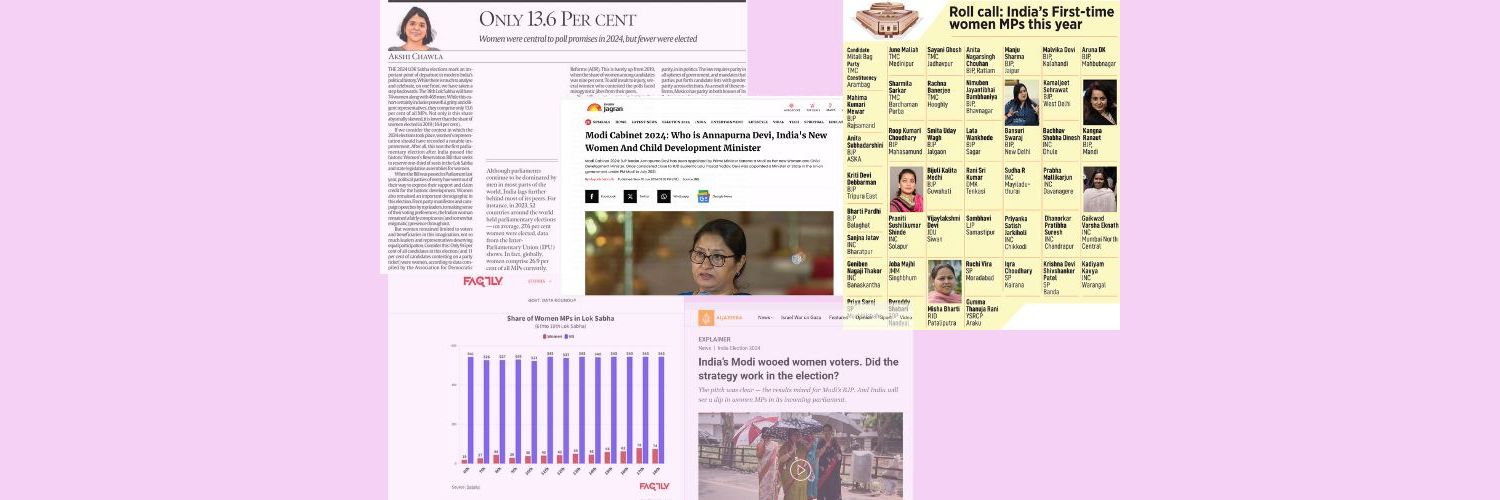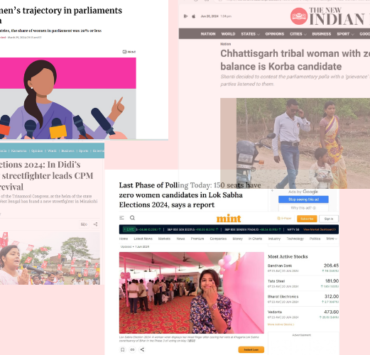
By Annie Philip

From 78 to 74. In the week following the results of the 2024 General Elections in India (June 4-12), the fall in numbers of women elected to the 18th Lok Sabha emerged as a major headline in coverage of the elections in English media (print and digital), especially within the country. The 74 women elected to Parliament make up just around 14 per cent of the Lok Sabha. There was also a dip in the number of women ministers in the union government – from 10 to 7, with only two in Cabinet-level roles.
The lower number of female MPs this time is, of course, a reflection of the lower number of female candidates standing for election: just around 10%. Media reports also pointed out that India’s ranking for women’s representation in the lower house of Parliament globally had also dropped.
These figures are especially pertinent in the context of the recently passed but yet to be implemented Women’s Reservation Act or the Constitution (One Hundred and Sixth Amendment) Act, which mandates reservation of one-third of seats in the Lok Sabha and state legislative assemblies for women, as well as the high turnout of women voters (nearly 66%, with women ahead of men in 19 states and Union Territories). The gender gap in voting has seen a significant reduction over the years, and IndiaSpend did a detailed analysis on the hows and whys of this.
A mismatch of voters to MPs
This contrast of the Indian woman as an important voter demographic vis-à-vis the poor representation of women in the Lok Sabha was highlighted in an opinion piece by Akshi Chawla in The Indian Express, which cautioned that the “dip in women’s representation should not be trivialised”. “Where is Nari Shakti?” asked YourStory in its analysis. Ria Chakrabarty’s opinion piece in The Hindu, aptly headlined “Indian women deserve the democracy they were promised”, recalled cases of sexual harassment in Indian politics and asked for women to be given a chance to independently drive political agendas. This would transform India’s political culture, she wrote. A “new political imagination” is needed for women to be leaders and decision makers in politics, exhorted an editorial in The Indian Express.
What women want
While the high turnout of women voters is a fact, Frontline pointed out that there has been a sharper decline in voter turnout among women than men as compared to the 2019 General Elections. It listed Uttarakhand, Haryana, Kerala, Punjab, Rajasthan, Gujarat, Madhya Pradesh, Uttar Pradesh, Tamil Nadu, Delhi and Manipur among the states where the proportion of women voters declined significantly from 2019 levels. But on a positive note, the article also pointed out that women from economically and socially vulnerable communities, like the Scheduled Castes and Scheduled Tribes, had a higher voter turnout compared to women of general categories this time. Al Jazeera chose to focus on how the Bharatiya Janata Party (BJP) wooed female voters with schemes targeting them, on how women ultimately voted and on how the party’s female candidates performed.
Both the Frontline and Al Jazeera stories touched upon the kind of impact women-centric government schemes had on women voters. The observations were based on the post-poll Lokniti-CSDS Survey which indicated that “perceptions of economic well-being at the household level” influenced voting behaviour among women, too.
Behanbox reported on women who found their names missing from voters’ lists and how they felt deprived of their right to vote in what was termed a historic election.
The media also reported on female voters turning up at the office of the Indian National Congress (INC) in Lucknow, expecting cash assistance as promised in the party’s promised guarantees if they were elected to power. That the party hadn’t won did not seem to matter to the women. This brought to light the miscommunication that can happen during campaigns.
In a fresh take, The Telegraph detailed the experiences of women election officials in Kolkata.
An analysis by The Indian Express showed that the newly elected women MPs are younger and less experienced compared to their male counterparts. News stories highlighted the fact that the Trinamool Congress (TMC) led the way among political parties in terms of women’s representation, with women making up nearly 38 per cent of their MPs. TMC Parliamentarian Derek O’Brien opined in a piece for NDTV that the party’s secret to success in this respect was placing women in winnable seats.
There were also stories in the media on the educational qualifications of women MPs, on Bengaluru finally getting its first woman MP, and on the performance of women candidates in various states like Odisha, Jharkhand, Karnataka, Uttar Pradesh and Maharashtra.
Meet the winners
This election also saw the regular fixture stories on high-profile wins and losses among women candidates. Longer profiles highlighted the diversity among women MPs: “Millennials, sarpanches and foreign degree holders: Meet India’s first-time women MPs” , “Meet Sofia Firdous, first Muslim woman to win assembly election in Odisha”, “Modi Cabinet 2024: Who is Annapurna Devi, India’s New Women and Child Development Minister”, “Against the tide: The women who fought and won in the 18th Lok Sabha against the ruling regime” and “Meet Geniben Thakor, the woman Congress leader and only non-BJP candidate to win Lok Sabha polls in Gujarat”.
Data journalism trends
English media has also drew on historical data on women voters, on female candidates and their performances, and on variations across different states and parties to publish data stories with charts and trends as part of their coverage of the elections.
While the use of data while focusing on the gender angle of elections is a welcome step, readers would benefit from such gender-based data journalism stories during non-election times, too. Schemes targeting women run all year and data stories looking at their implementation and efficiency would be a good addition to media coverage.
Annie Philip is an independent journalist.





The Author has taken an earnest effort to highlight the percentage of women electorate in India/s electoral rolls ,the No.of candidates contested and the candidates who won the elections .It is a very good statistical analysis and a pointer for implementing the Women’s Reservation in its true spirit without any delay .